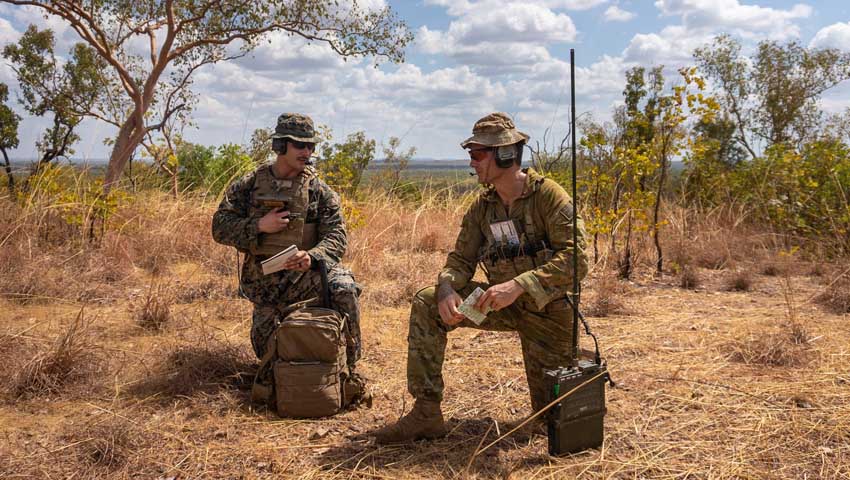The US Marine Corps, in partnership with the US Air Force and Australian Defence Force, took a major step towards multinational interoperability as a combined task force during a major training scenario throughout August.
To continue reading the rest of this article, please log in.
Create free account to get unlimited news articles and more!
The scenario focused on a small naval expeditionary force’s ability to rapidly deploy, integrate with foreign partners, co-ordinate airstrikes and call for close air support on targets within contested environments.
Marine Rotational Force – Darwin (MRF-D) and Australian Army joint terminal attack controllers (JTACs) worked alongside Australian Army Tiger armed reconnaissance helicopters and Marine Corps RQ-21A Blackjacks to identify and surveil notional targets.
The staffs co-ordinated airstrikes from US Air Force B-1B Lancers with the 37th Expeditionary Bomb Squadron and B-2 Spirit stealth bombers with the 393rd Bomb Squadron, before passing those same aircraft to tactical units to conduct close air support.
The aircraft, deployed to the Indo-Pacific region as part of Pacific Air Force’s Bomber Task Force, flew from locations as far as 6,423 kilometres away to conduct the missions in the Australian Northern Territory.
In a release by the bomber task force, Lieutenant Colonel Christopher Conant, the task force’s commander, said, "We are sharpening our lethality while strengthening relationships with key allies, partners and our sister service teammates."
This was reinforced by MRF-D US Marine Colonel David Banning, who said, "We work better when we work together."
Banning said the success of multinational co-ordination of this scale is a testament to the US-Australian alliance and defence ties as well as MRF-D’s capability as a forward-positioned force, able to quickly respond to a variety of security challenges.
Col Banning added, "MRF-D’s ability to integrate with our sister services located across the Indo-Pacific region and Australian Defence Force partners, speaks to our overall capacity to contribute to regional security. This unique training event has helped MRF-D demonstrate our capacity to co-ordinate actions across a wide area in a bilateral, joint environment."
The exercise design was driven by the Marine Corps’ modernisation plan, which seeks to make Marines "first on the scene, first to help, first to contain a brewing crisis, and first to fight if required to do so", according to Commandant of the Marines Corps, General David Berger’s planning guidance released in 2019.
The plan calls for Marines to operate from forward expeditionary bases as a fast and mobile force in order to conduct a variety of missions that help set conditions for larger naval forces.
US Air Force strikes were also conducted with US Marine and Australian Army JTACs.
Australian Army Sergeant Aaron Costes, a JTAC with 102nd Coral Battery, said, "It’s imperative that the US Marine Corps and Australian Army work together. It’s such a feat that we can infill and have an aircraft come in from such long distances."
The exercise did not just demonstrate the execution of long-range strike, but also the targeting and tasking function of MRF-D, the III Marine Expeditionary Force Fires and Effects Coordination Cell, and III MEF Information Group’s Space Operations Cell with joint and combined forces.
US Marine Corps Captain Benjamin Hovies, the MRF-D air officer, added, "The most impressive thing was that [we] came together at the lowest echelon of leadership, brought assets from across the globe to accomplish a common task in spite of a COVID environment."
The training comes on the heels of a major strategic meeting between US Secretary of State Mike Pompeo and Secretary of Defense Mark Esper with Australian Minister for Foreign Affairs Marise Payne and Minister for Defence Linda Reynolds in Washington, DC, on 28 July 2020.
During the meeting, the officials "acknowledged that the presence of US forces in the Indo-Pacific has been vital to preserving the region’s security and prosperity for 75 years", according to the Joint Statement Australia-US Ministerial Consultations 2020.
While significant for the Marines, the incorporation of US bombers was also a major step for the US Air Force’s transition, which seeks to pre-position bombers forward in the Indo-Pacific from a broad array of overseas locations with greater operational resiliency.
The bombers participating in the exercise also conducted missions with US Air Force F-15C Eagles from Kadena Air Base, Okinawa, USS Ronald Reagan Carrier Strike Group, F-35B Lightning IIs assigned to Marine Corps Air Station Iwakuni, and F-15J aircraft from the Japan Air Self-Defense Force.
In an era where defence ties between the US and allies are critical to regional security and co-operation, the rotational deployment of the Marine force to Darwin builds US-Australian capacity to quickly respond to a variety of security challenges and maintain a postured and ready force in the region.
Stephen Kuper
Steve has an extensive career across government, defence industry and advocacy, having previously worked for cabinet ministers at both Federal and State levels.

 Login
Login








